
Urban Green Spaces: The Future of Outdoor Living in European Cities by 2025
Urban Green Spaces are becoming increasingly important in European cities, and their significance will only continue to grow by 2025. As the world becomes more urbanized, the need for green spaces in cities is becoming more pressing. Not only do these spaces provide a tranquil escape from the hustle and bustle of city life, but they also play a crucial role in maintaining the physical and mental health of urban residents.
What are Urban Green Spaces?
Urban Green Spaces refer to areas of greenery in urban environments, such as parks, gardens, and green roofs. These spaces can be found in a variety of settings, from small urban gardens to large city parks. They provide a range of benefits, including air purification, noise reduction, and climate regulation, making them an essential component of sustainable urban planning.
Benefits of Urban Green Spaces
The benefits of urban green spaces are numerous and well-documented. Some of the most significant advantages include:
- Improved air quality: Urban green spaces help to remove pollutants from the air, improving the overall air quality in cities.
- Reduced noise pollution: Green spaces can act as a buffer, reducing the noise levels in urban areas.
- Climate regulation: Urban green spaces help to regulate the urban microclimate, reducing the urban heat island effect and mitigating the effects of extreme weather events.
- Improved mental health: Spending time in nature has been shown to have a positive impact on mental health, reducing stress and anxiety.
- Increased biodiversity: Urban green spaces provide a habitat for a range of plant and animal species, helping to maintain biodiversity in urban areas.
European Cities Leading the Way
Several European cities are leading the way in terms of urban green space development. Cities such as Copenhagen, Stockholm, and Amsterdam have incorporated green spaces into their urban planning, creating sustainable and livable cities. For example, Copenhagen’s green roof initiative has provided a range of benefits, including reduced stormwater runoff and improved air quality.
Challenges and Opportunities
While urban green spaces offer many benefits, there are also challenges to be addressed. One of the main obstacles is the lack of space in urban areas. However, this can also be seen as an opportunity to think creatively about green space design. For example, green walls and green roofs can provide a range of benefits, even in areas with limited space.
Conclusion
Urban Green Spaces are the future of outdoor living in European cities. As the world becomes more urbanized, the need for green spaces in cities will only continue to grow. By incorporating green spaces into urban planning, cities can create sustainable, livable, and healthy environments for their residents. With the benefits of urban green spaces being so numerous, it is essential that we prioritize their development and maintenance in the years to come.





